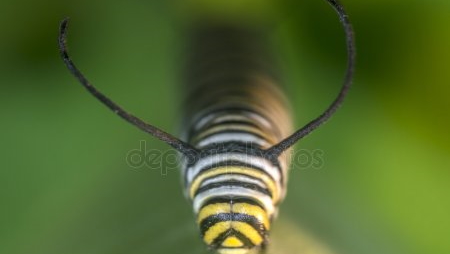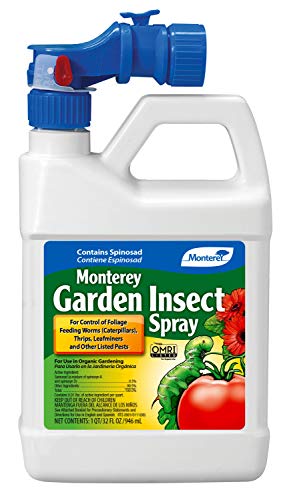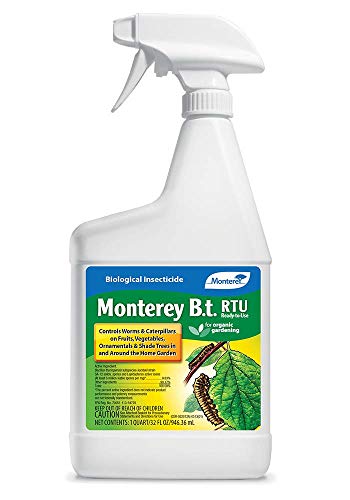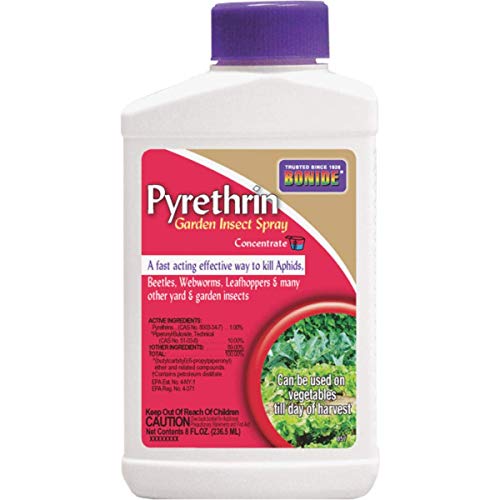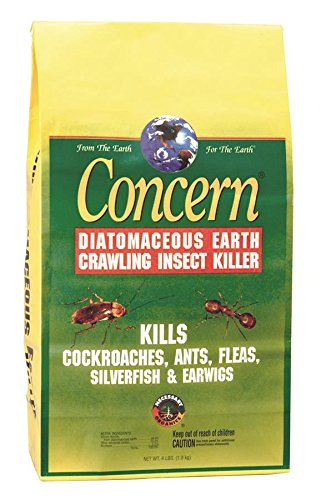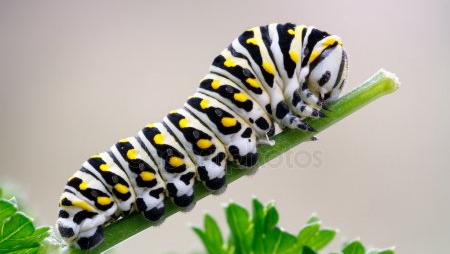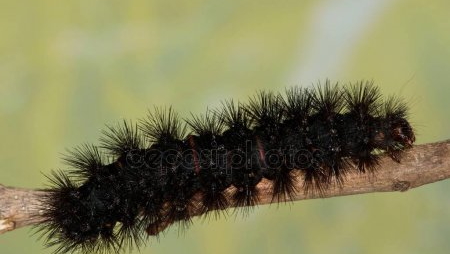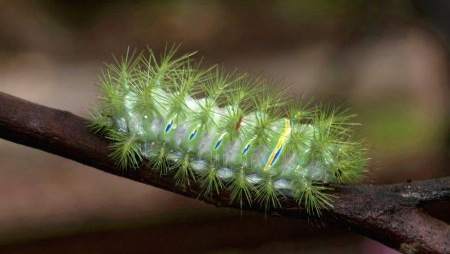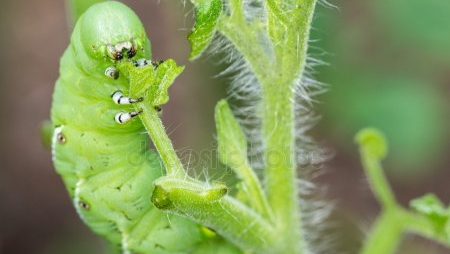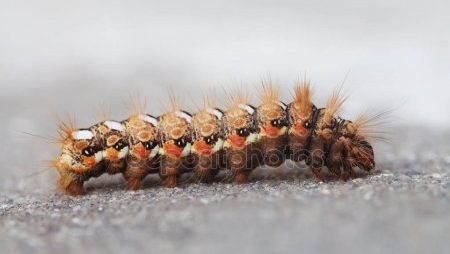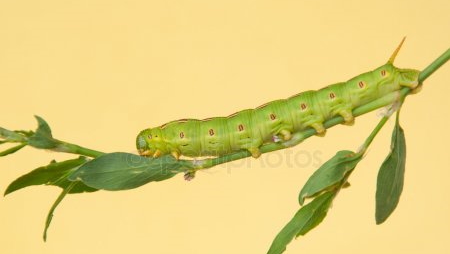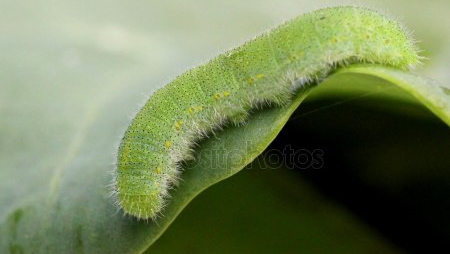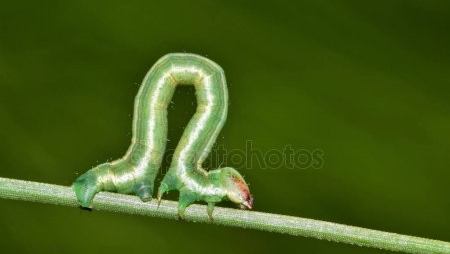Caterpillars are the larval stage of the order Lepidoptera, which mainly comprises of the insects such as butterflies and moths. Due to the indirect transition of these insects from caterpillars to adults, caterpillars require a huge amount of food to gain enough energy to undergo a complete metamorphosis and to become a healthy adult. They typically increase their weight by thousands of times in a span of a few months.
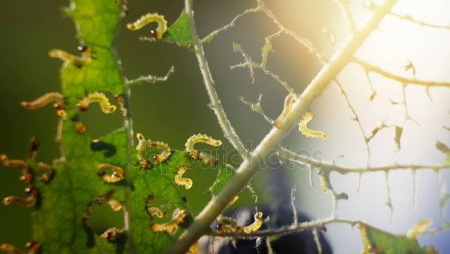
How to get rid of Caterpillars?
Since it has been established that caterpillars are pests and unwanted in most cases, some important remedies must be done in order to take care of any outbreak in a garden. Some conventional methods, as well as the use of some natural pesticides, can help tackle the caterpillars in a garden. The most commonly used methods are listed below.
It’s necessary to look for the home remedies to get rid of caterpillars but priority is to control caterpillars instantly if they have already invaded your garden. Here are some organic & natural solutions first. In addition to home remedies, some products are available commercially which can help control a caterpillar infestation in the garden. These insecticides are both, organic and inorganic in nature. Some products are listed below.
#1 Monterey Garden Insect Spray with Spinosad (Chemical – Editors’ Choice)
Spinosad is also comprised of bacteria and is made by fermentation that contains both spinosad A and Spinosad D as its active ingredient at 0.5%. The results of the application appear quite quickly in at most 2 days. The concentrate should be diluted with a ratio of 4 tablespoons of concentrate to one gallon of water and should be thoroughly sprayed on the crop. It’s used to control caterpillars, inchworms, cabbage worms, loppers, and little green worms on edible plants. Spray your plant foliage thoroughly using a mist sprayer in the evening. This is an organic product and there is no harm in using it to any edible garden.
#2 Monterey Bacillus Thuringiensis (B.t.) Worm (Natural – Editors’ Choice)
This product contains BT that is a species of bacterium which works significantly well against caterpillars and worm type insects such as cabbage worms, Spotted bollworm, inchworms, fall helianthus, and several leaf-eating worms and compatible to use on a variety of the edible plants including microgreens, herbs, broccoli, beans, cauliflower, tomatoes, and lettuces. It doesn’t adversely affect birds, honeybees, ladybugs and other beneficial insects on your edible plants. Its classified organic product that can be used on the day of the harvest. It’s ready to use to apply directly to plants using a builtin trigger for the spraying purpose.
#3 Orcon Live Trichogramma
Trichogramma species are effective at destroying leaf-eating worms and tiny green worms on cabbage and other leafy greens. Trichogramma also attacks the eggs of the cabbage worms and destroys them before coming into hatching position and most prominent being the American bollworms. Parasitic Trichogramma lay their eggs inside the eggs of the caterpillar after locating them on plants. Their hatching takes place on the eggs of caterpillars which are eaten by Trichogramma before they hatch. Then they emerge as adults to continue their life cycle. It is a natural and completely harmless process as even the adult wasps are barely visible and do not harm other beneficial insects except the caterpillars. Care must be taken to not release during or after an insecticide spray as it may kill these beneficial parasitic wasps in your garden. It is seen to be effective in the elimination of green caterpillars.
#4 Bonide Neem Oil Repellent
Bonide Neem Oil is a perfect pest control option that contains 70% Neem oil extracted from the seeds of Neem plants and is widely used in the organic gardening for controlling small green worms at the initial stages. It works as an insecticide, fungicide, and miticides as well and is effective on the variety of caterpillars including tiny green worms and wooly bear caterpillars. This product is great to be used on all edible greens, roses, and ornamental plants.
32 ounces bottle comes in ready to use concentrate with a convenient spray nozzle. Just spray on the spotting of any of the listed worms in your garden. It is safe and organic that can be sprayed on the day of harvest.
#5 Bonide – Pyrethrin Garden Insect Spray: (how to get rid of silkworms?)
Its active ingredient is 1% pyrethrin that is derived from the chrysanthemums. This is a fast and effective way to kill webworms, leafhoppers, monarch caterpillars, and silkworms on vegetables especially asparagus, broccoli, tomatoes, peppers, and beans in an edible garden. Its mode of action is to target the nervous system and block feeding that leads to dehydrate caterpillars on your plants. It degrades rapidly after being exposed to climate and leaves no harmful effects on edibles or climate.
Add 3 tablespoons of concentrate in1 gallon of water using a mist sprayer to spray on the entire foliage of plants under attack.
#6 Tengard SFR One-Shot Liquid Insecticide
Although not an organic insecticide, this product is advantageous over its organic counterparts due to its longevity and systemic activity. Having Permethrin as the active ingredient, it is effective against many pests, including caterpillars. However, it has side effects as the poisonous residual may remain in the soil for 60 days. Similarly, being a proper insecticide, it can eradicate the beneficial insects as well. However, the product is economic as one bottle makes 96 gallons of spray. Add 1/3rd ounces of insecticide in 1 gallon of water using a power sprayer to cover damaging areas of caterpillars in your garden.
Home Remedies (how to kill caterpillars?)
#7 Killer Oil-Soap Spray
By mixing 1 tablespoon of mild liquid soap and 1 cup of vegetable oil of choice, an effective insecticide can be made, which is to be sprayed directly on the affected plant. For a larger infestation, mixing 2 teaspoons of the mixture and 1 quart of water and spraying it on the affected area will help.
#8 Diatomaceous Earth Spray
Diatomaceous Earth is made from fossilized algae and remains of diatoms. Due to its excessive absorbing ability, a solution to it can be sprayed on the infected plant to get rid of the caterpillars. The solution is formed by mixing 4 tablespoons of diatomaceous earth in 1 gallon of water.
#9 Cabbageworms home remedy
Neem oil is a natural insecticide and hence, must be used with caution so as not to harm the beneficial insects. Diluting a small amount of neem oil (2 ounces or less) in 1 gallon of water and lightly spray the affected area will kill the cabbage worms on edible plants.
Another best strategy to kill cabbage worms is to dust the leaves of the plants with baking soda. Baking soda dehydrates cabbage worms and kills them on your edible plants. It’s safe to use and has no harmful effects on edible plants.
#10 Cover the Plants
Covering the plants with a thin mesh will keep them safe from the Lepidoptera adults, looking for a host to lay eggs.
#11 Complementing the Garden
Some strong-smelling plants will act as natural repellents for the caterpillars, so planting such plants in the garden will keep it less attractive to the caterpillars. These plants include Peppermint, Lavender, Mugwort and Sage, etc.
#12 Making the Garden Friendly for Birds
By attracting natural predators of caterpillars to the garden, their outbreak can be controlled. Setting up birdbaths and bird feeders may help the cause.
what do caterpillars eat?
Lepidoptera insects, in their caterpillar form, are voracious feeders and are one of the serious agricultural pests. Most species of moths in their caterpillar stage cause serious damage to fruits and agricultural produce. Therefore, a gardener must take measures to tackle this problem.
How many legs do caterpillars have?
Caterpillars of almost all insect species are herbivorous and nocturnal in nature, feeding primarily on leaves during the night. However, a few species are carnivorous while some feed on animal products such as wool, hooves, and horns, etc. Caterpillars can be easily identified by their eruciform body shapes. They most often have 3 pairs of true legs and five pairs of prolegs, making 16 legs in common. Some exceptional species of butterfly caterpillars, however, have no legs at all.
How long do Caterpillars live?
The caterpillar stage is not the final stage in the life cycle of Lepidoptera, therefore, the time span for which a Lepidoptera remains a caterpillar varies from species to species. The time for which some famous parasitic caterpillars do not transition to their pupal stage is given below.
- Inchworms – depending upon the amount of food available, inchworms may turn into their pupae in 2 to 4 weeks.
- Woolly bears – these caterpillars are found in the Arctic and hence, are adept at coping with such extreme temperatures. The life cycle of woolly bears can span up to 14 years due to the fact that they hibernate in extreme winters.
- Silkworms – they remain in their larval stage for 24 to 33 days.
- Monarch Caterpillars – in peak summer and warmer climates, the monarch caterpillar takes about 10 to 14 days to transition to the pupal form.
- Cabbage worms – they take almost 17 to 18 days to convert from their larval to the pupal stage after hatching.
Commonly found Garden Caterpillars
As most of the caterpillars are herbivorous in nature, they are naturally attracted to any greens which are grown in gardens. The adults will lay their eggs on their prioritized plants, which results in the appearance of caterpillars, which may be a cause of alarm for the gardener. Caterpillar identification can be a difficult task as many of them are excellent at camouflage and can remain hidden for long periods of time. In the case of extreme parasitic caterpillars or an infestation, it becomes necessary for the gardener to save their produce by taking appropriate measures. Most caterpillars appear green for camouflage in their habitat, so it may be laborious to identify the type of caterpillars. Some of the caterpillars, most commonly attracted to a garden, are listed below.
#1 Black Swallowtail (what do monarch caterpillars eat?)
Black Swallowtail caterpillar disguises as a Monarch caterpillar due to the reason that the Monarch caterpillar emits toxins from its body, which keep the predators away. Black Swallowtails mostly feast on Parsley, Carrots, and Dill. Therefore, if present in large numbers, they may damage these crops. Carrot greens are the most susceptible target for these caterpillars. Although they harm the crops, they are not harmful upon direct contact with the gardener.
#2 Woolly Bear(what do wooly bear caterpillars eat?)
Woolly bear caterpillars develop into Tiger Moth and are one of the most persistent caterpillars found in nature. Due to their habitat, they have bodies covered in thick fur. As they are found in the Arctic, where the temperatures in winter can be extreme, the caterpillars tend to hibernate, with their bodies producing natural antifreeze. Due to this ability, the life span of Woolly bears is about 10 to 14 years, mostly spent as a caterpillar. A whole lot of nutrition is required for the caterpillar to turn into its adult form, so, Woolly bears eat almost every green plant, from Oak trees to Dandelions. However, they seldom inflict serious damage upon the crops.
#3 Io Moth Caterpillar
These caterpillars belong to the group of Giant Silk Moths and are one of the few species of caterpillars, whose sting can cause serious infections in human beings. Their bodies are covered with spines which, upon contact, release toxins, resulting in rashes, allergies and in severe cases, death. Hence, it is advisory to take precautions while approaching such caterpillars. An infestation of these caterpillars in the garden can seriously damage it, as these caterpillars feed on a variety of garden plants, including Roses, Pin Cherry, Indigo, Oak, etc.
#4 Tomato Hornworm
Tomato hornworms are relatively huge caterpillars, found on many plants from the Solanaceae family. Although they have a horn on their tail, thus the name, Tomato hornworms are not dangerous to human beings and do not sting upon contact. However, as they feed on many beneficial plant species such as Tomato, Eggplant, Pepper, Tobacco, Moonflowers, and Potato, they are a serious parasite and can inflict great damage on the crops, eating up the entire plant.
#5 Genista Broom Moth Caterpillar
Although single-handedly, these caterpillars are not that harmful, as they have small-sized bodies and do not consume much on their own, they are considered a major threat to plants from Baptisia species, especially Blue False Indigo. The reason for this is that they are often in large numbers and attack the plants in the form of a small army, thus destroying the plant completely. Therefore, it is important to keep the plants safe from the swarms of these caterpillars.
#6 Copper Underwing Moth Caterpillar
They are a common caterpillar, found frequently in the gardens. These caterpillars are huge in size, and can often be mistaken for Tomato Hornworm caterpillars. Like Gensita Broom caterpillar, these caterpillars also appear in the form of large groups, hence the plants which are exposed to them can get seriously damaged. They are also considered as a dangerous parasite since they mainly attack fruit-bearing plants like Apple, Walnut, Grapes, Raspberry, Oak, Maple, Basswood, Hawthorn, etc.
#7 White-Lined Sphinx Moth
Belonging to the family of Hawkmoths, these caterpillars also attack the plants in swarms, inflicting major damage to the crops. In the same manner, as the Copper Underwing caterpillars, these caterpillars also target the edible crops in large numbers, hence pose a great threat to the product in a garden. The main targets of these caterpillars are Apple, Elm, Willow, Grape, Tomato, Fuchsia, and Primrose, etc.
#8 Cabbage White Caterpillar
One of the major species of caterpillars that are considered to be pests, Cabbage Whites can be found in quite an abundance in the wild as well as domestic greens. They are very common and are most probably present in almost all untended gardens. Since they have a soft green color, they are perfectly camouflaged with the cabbage leaves thus making them less visible to the eye. Cabbage worm poop can be seen on the leaves as black dots. As the name implies, Cabbage Whites can eat all cabbage related crops such as Green Cabbage, Red Cabbage, Brussels Sprouts, Bok Choy and Kale, etc.
#9 Cabbage Looper Moth Caterpillar
Another common type of agricultural pests is the Cabbage Looper caterpillars. Unlike their butterfly counterparts, Cabbage Loopers move around by arching their backs in a loop like a shape, thus attaining the name. it would not be wrong to say that the crops from cruciferous plants get inflicted by these caterpillars at least once during their growth. In a similar manner to the Cabbage Whites, the Loopers tend to attack Carnations, Nasturtium, Lettuce, Spinach, Beets, Parsley, Potatoes, and Tomatoes in addition to Cabbage, Cauliflower, Broccoli, and Brussels Sprouts. Proper measures must be taken to rid the garden from these parasites. The disposal of these caterpillars can also result in the stunted growth of the Cabbage, Brussel sprouts, and Broccoli flowers, etc.
#10 Inchworms (what do inchworms eat?)
In the same way such as some species of caterpillars explained above, Inchworms also tend to attack the garden in the form of hordes thus causing substantial damage to the vegetables or fruit trees growing there. They also exhibit a loop like motion by arching their backs, hence they are also referred to as Loopers. They usually feed on orchard trees such as Apples, Oak, Mulberry and Elm Trees, etc.
#11 Silkworms
Silkworms belong to the species of caterpillars which, although being parasitic, are used for cultivation of silk, used in the fabric industry. On a commercial level, Silkworms are bred and raised for the sole purpose of harvesting silk from their pupal form. However, in a domestic garden, Silkworms prove to be parasitic and can harm the crops. In industry, Silkworms are fed Mulberry leaves, which help them in producing good quality silk. In a garden, however, they can feed on Lettuce, Beetroot or Cabbage leaves.
#12 Monarch Caterpillars
One of the most beautiful and most commonly known species of butterfly is the Monarch butterfly. The caterpillars are commonly found in the wild as well as in domestic green settings. Monarch butterflies are migratory and travel large distances to reach a place of moderate temperatures. The food for Monarch caterpillars in Milkweed, which is a pest itself. Hence, there is a shortage of Milkweed plants due to their excessive mowing by the farmers and gardeners. However, due to the shortage of host plants, experiments have been conducted and it is seen that Monarch caterpillars can be fed pumpkins and cucumbers in their late larval stages. These caterpillars are not parasitic; hence they are not redundant or harmful for a gardener.
